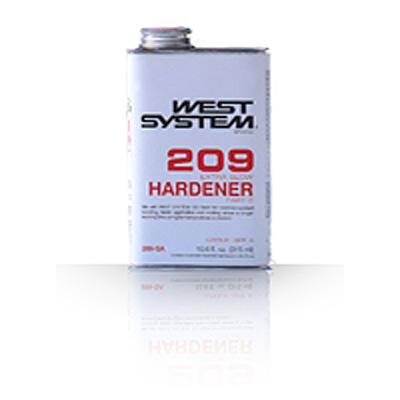Pot life at 72°F (22°C): 40 to 50 minutes
Pot life at 95°F (35°C): 15 to 20 minutes
Cure to a solid state at 72°F (22°C): 20 to 24 hours
Cure to a solid state at 95°F (35°C): 6 to 8 hours
Cure to maximum strength at 72°F: 4 to 9 days
Minimum recommended temperature: 70°F (21°C)
Warm Weather Bonding with 209 Extra Slow Hardener
WEST SYSTEM Epoxy’s cure times are based on an ambient temperature of 72°F. In warmer temperatures, epoxy cures faster. Here is what you need to know to ensure adequate working time when using epoxy in warm conditions.
Epoxy cures by a chemical reaction between the resin and hardener that releases heat, called an exothermic reaction. The larger the volume of epoxy the more heat that is generated. Many epoxy users have seen pots of epoxy smoke and bubble due to uncontrolled exotherm. The good news is you can do to prevent this. A good rule of thumb for gauging cure speed is that for every 18°F increase above 72°F, the working time and pot life will be cut in half. To maximize the working time of the epoxy, consider how much time you need and what temperature you’ll be working at, then select the hardener accordingly. For hot temperatures, we recommend 209 Hardener.
Epoxy Pot Life v. Working Time
The pot life listed on the WEST SYSTEM technical data sheets refers to a confined mass of 100 grams of epoxy at 72°F. Pot life is always shorter than working time because epoxy contained in a pot kicks off faster than epoxy spread into a roller pan (thin film). Spreading out the epoxy dissipates heat, extending its working time.
For best results when working in warmer temperatures, select the 206 Slow Hardener or 209 Extra Slow Hardener for best results. 209 offers the most working time at higher temperatures.
To maximize working time and minimize waste, mix an epoxy batch size that you can use within half of the pot life. 209 provides 20-30 minutes of working time at 72°F. This approach lets you continue using the same mixing pot, mixing stick and roller cover or glue brush. The 300 Mini Pumps meter approximately 1 fluid ounce per pump stroke so you can mix small batches quickly and accurately.
After thoroughly mixing 105 Resin and 209 Hardener, pour the epoxy into roller pans or onto the substrate. This increases the surface area so heat buildup (exotherm) can dissipate, slowing the epoxy’s reaction.
An Epoxy Cooling Box
To slow epoxy’s reaction in very warm temperatures, create a foam cooling box that is glued together and sealed to hold your roller pan. Fill the inside of the foam box with tap water that will act as a heat sink and increase epoxy’s working time. An ice cube or two can be added to the water bath as long as you do not chill the epoxy too much. Chilling the epoxy too much can cause moisture in the air to condense on the epoxy. Moisture can cause the epoxy to cure at a faster rate, become cloudy and reduce its cured physical properties.

